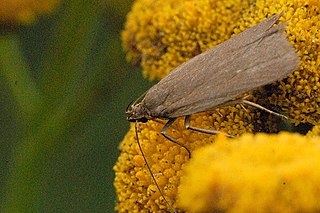
Scrobipalpa acuminatella is a moth of the family Gelechiidae. It is found in most of Europe, as well as Turkey, southern Siberia, Central Asia and China (Anhui). It was recently reported from Canada, with records from Ontario and Québec.

Athrips mouffetella is a moth of the family Gelechiidae. It is found from central and northern Europe to the Ural Mountains, Siberia and the Russian Far East. It has also been recorded from North America.

Recurvaria leucatella is a moth of the family Gelechiidae. It is found in most of Europe, Turkey, Central Asia and the Caucasus.
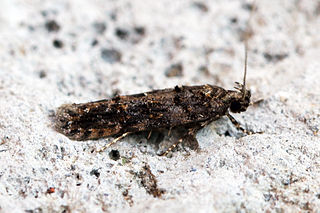
Teleiopsis diffinis is a moth of the family Gelechiidae. It is found in Europe, North Africa, the Near East, central Asia and Siberia (Transbaikalia).

Carpatolechia proximella is a moth of the family Gelechiidae. It is found in most of Europe, Turkey, the Caucasus, Central Asia and Siberia.

Monochroa lucidella is a moth of the family Gelechiidae. It is found in most of Europe, except Spain, Switzerland and most of the Balkan Peninsula. It is recorded from the Near East and Siberia (Transbaikalia).
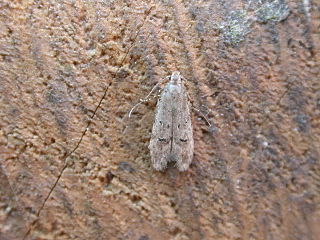
Teleiodes vulgella is a moth of the family Gelechiidae. It is known from most of Europe, east to the southern Ural and the Volga region.

Caryocolum fraternella is a moth of the family Gelechiidae. It is found in Ireland, Great Britain, Fennoscandia, Denmark, Germany, the Netherlands, France, Switzerland, Spain, Latvia, Estonia and Ukraine.
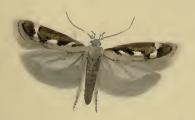
Caryocolum marmorea is a moth of the family Gelechiidae. It is found from Scandinavia to the Mediterranean islands, and from Ireland to Poland, Hungary and Greece. It is also found on the Canary Islands and Madeira. It is also found in North America.

Bryotropha domestica is a moth of the family Gelechiidae. It is found from Ireland to Germany, Slovakia, Romania and Bulgaria and from the Benelux to the Iberian Peninsula, Sicily, Crete and Cyprus. It is also found in Morocco, Algeria, Tunisia, Libya, the Middle East, Turkmenistan, Saudi Arabia and Yemen.

Mirificarma mulinella is a moth of the family Gelechiidae. It is found in most of Europe, except Finland, the Baltic region and part of the Balkan Peninsula. It has also been recorded from North Africa.

Athrips tetrapunctella is a moth of the family Gelechiidae. It is found in France, Great Britain, Ireland, Fennoscandia, Denmark, Estonia, Latvia, Russia and Ukraine. In the east, the range extends through the southern Ural and Siberia to Primorsky Krai.
Monochroa suffusella, the notch wing neb, is a moth of the family Gelechiidae. It is found from Fennoscandia to the Pyrenees and Alps and from Ireland to Romania. In the east, the range extends to Japan. The habitat consists of bogs, fens, swamps and salt-marshes.

Carpatolechia notatella, the sallow-leaf groundling, is a moth of the family Gelechiidae. It is found in most of Europe and Turkey.

Metzneria metzneriella is a moth of the family Gelechiidae. It is widely distributed throughout Europe, as well as Turkey and southern Siberia. The habitat consists of dry pastures and calcareous soils.

Ptocheuusa paupella, the light fleabane neb, is a moth of the family Gelechiidae. It is found from central and southern Europe to the Ural Mountains. It is also found in Turkey and India.

Teleiodes luculella, the crescent groundling, is a moth of the family Gelechiidae. It is found from Europe to the southern Ural and Transcaucasia. The habitat consists of woodlands, including oak woodlands.

Gelechia rhombella, the apple groundling, is a moth of the family Gelechiidae. It is found in Europe, the Caucasus, Transcaucasia, southern Siberia, the Russian Far East, Korea and China.
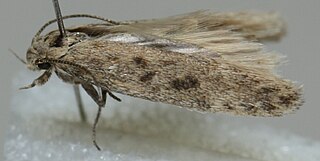
Scrobipalpa obsoletella, the summer groundling, is a moth of the family Gelechiidae. It is found in most of Europe, Turkey, the Caucasus, from Iran to Asian Russia (Transbaikal) and Mongolia. It has also been recorded from New Zealand, South Africa and North America, where it is probably an introduced species. The habitat consists of coastal salt marshes and sandy beaches.

Scrobipalpa instabilella, the saltern groundling, is a moth in the family Gelechiidae. It was described by John William Douglas in 1846. It is found in on the Canary Islands, in Algeria, Ireland, Great Britain, Portugal, Spain, France, Belgium, the Netherlands, Germany, Denmark, Italy, Sardinia, Sicily, Greece, Cyprus and Palestine. It is also present in the United States, where it has been recorded from California.



















